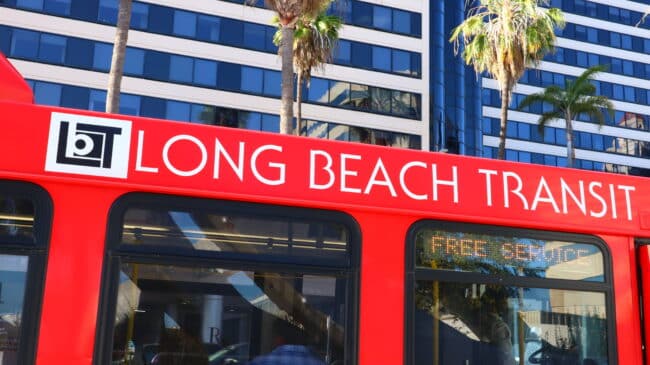As California faces a $24 billion budget deficit and transit agencies approach a fiscal cliff due to dwindling ridership, some public transportation advocates have called for eliminating customer fares to increase ridership. But forgoing this source of revenue would worsen financial problems and transit’s already gloomy outlook because decades of research have found that ridership is more sensitive to service quality than fare price.
Instead, advocates should be more realistic about transit’s role in providing transportation and demand efficiency improvements so transit can function well in the niche markets where it can provide the most value.
Nationwide, transit ridership in Dec. 2022 remained 34% below pre-pandemic Dec. 2019 levels, with sharper declines for rail service, which tends to serve wealthier riders, than for buses, which tend to serve lower-income riders. These transit declines have been an even bigger problem in California, with ridership on bus-heavy Los Angeles Metro carrying 39% fewer passengers than in Dec. 2019 and San Francisco’s Bay Area Rapid Transit (BART) rail system down 62%.
Transit experts are increasingly expecting a prolonged ridership winter, with ridership forecasted to remain below 2019 levels at least through the 2020s. As this likelihood has started to set in, some transit advocates have called for desperate measures to regain lost ridership, most notably transitioning to fare-free transit.
Ending fare collection can increase transit ridership, but it may also starve agencies of revenue that could be used to improve service. A January 2023 literature review published by the UCLA Institute of Transportation Studies found that decades of transportation research consistently shows that transit ridership is more sensitive to service quality than price, concluding that “service improvements are likely to be a more effective use of resources than fare reductions, even for low-income riders.”
It is also important to note that not all transit ridership gains are created equal. Transit is often sold to the public as a solution to traffic congestion and pollution. But fare-free transit would likely draw very few new riders who can drive their own cars. Those additional trips may instead come mostly from people who are already dependent on transit and people who would have otherwise walked or biked but take the transit trip because they don’t have to pay for it. While fare-free transit can provide private benefits to riders, it is unlikely to meaningfully address the social costs of driving.
The biggest problem facing transit is that it tends to poorly serve the needs of most California residents. In 2019, Los Angeles metro area residents could, on average, access 20% of area jobs in 30 minutes by car, compared to just 6% of jobs in 60 minutes by transit. In the Bay Area, drivers could access 27% of jobs in 30 minutes, while transit riders could access only 17% in 60 minutes. This significant divide will likely persist, regardless of how much money is spent on transit.
Like the rest of the country, transit’s future in California faces strong headwinds. Instead of eliminating fares, leaders should focus on improving service for those most dependent on transit to meet their daily needs. And for transit to continue serving a valuable role in the few places where it can compete, transit agencies must rethink the services offered.
Officials should adjust commuter-centric transit network designs and create schedules that account for remote and hybrid work, which is expected to remain significantly elevated above its pre-pandemic commuting share.
In California, they must somehow get transit construction costs, which dwarf the costs incurred by peer countries in Europe and elsewhere for similar projects, under control. They should prioritize buses over rail and consider smaller alternatives to serve routes with fewer customers better.
Finally, transportation officials should pursue new technologies that could significantly reduce operating costs, especially automation, even if that means taking on powerful public employee unions.
None of this will be easy, but rather than eliminating fares, California’s political and transportation officials should improve the quality of the transit services and adapt to today’s work and travel patterns.
A version of this column was first published in The Orange County Register.

